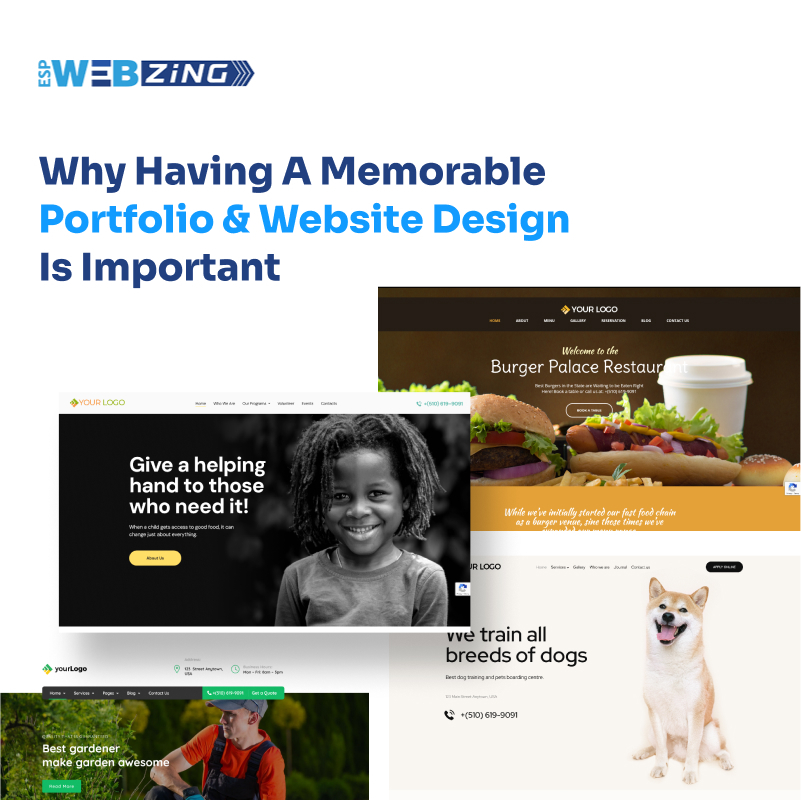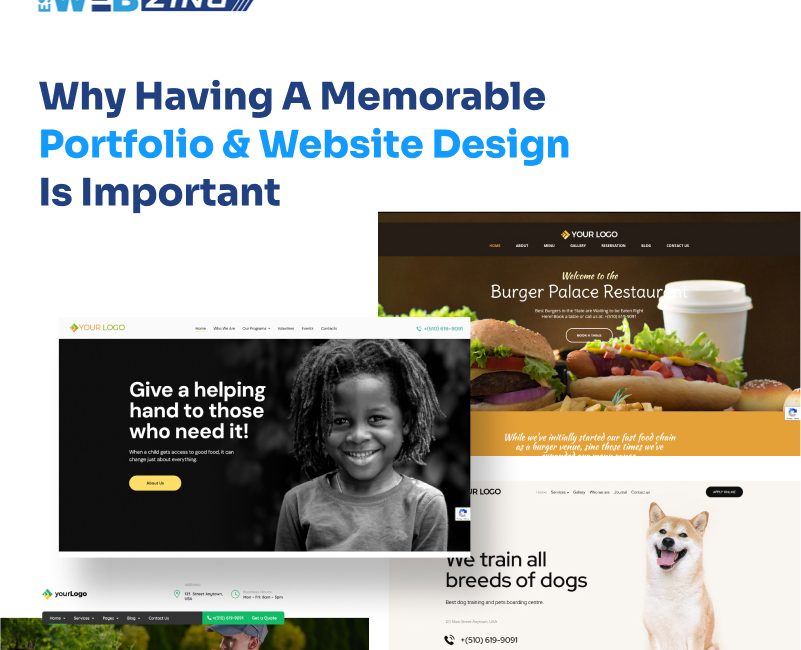Regardless of your specialization, owning a personal website is a brilliant way to exhibit your work to a global audience. In this guide, we’ll lead you through constructing a portfolio website that effectively showcases your talents.
It’s time to get things underway! Today, we’ll talk about portfolio websites and identify the individuals who can benefit from them.

You’ll become adept at creating a visually stunning website that showcases your work in a distinctive manner and recognizes its importance. The objective is to leave a lasting impression on your visitors and potential clients, ensuring they remember you for their next project.
A portfolio website is your digital showcase, a carefully curated online space that puts your finest work in the spotlight. It’s like having an online gallery dedicated to your talents, where you can captivate the attention of the press, potential collaborators, and prospective employers.
What is a Portfolio Website?
Conceive it as your online self-presentation platform, a virtual space where you narrate your story, showcase your professional achievements, curate an extensive collection of creative projects, share your personal interests, and provide a diverse range of contact pathways, making it a multifaceted, all-in-one representation of your online identity.
Check the Example of a Portfolio Website
Why Should You Have One?
Sure, you have various options to showcase your work on platforms like Instagram, Tumblr, or Behance. But having your own portfolio website offers a range of unique advantages:
Total Control Over Your Online Presence
Your portfolio website provides you with the freedom to dictate how you want to be seen online. Unlike other platforms that might restrict you to specific formats and designs, here, you’re the master.
Choose the layout, one of the best portfolio website designs, image sizes, and fonts that best represent you and your work.
Enhanced Discoverability
Imagine making it easier for potential employers or admirers to find you online. Your portfolio website is the key to that. By incorporating the right search terms and tags, your website can soar to the top of search results.
It’s like having a beacon that guides people straight to your digital doorstep, especially useful if you share a common name.
A Reliable Home for Your Work
While social media platforms are fantastic for showcasing your creations, they come with a degree of risk. Your portfolio website acts as a secure vault for your work. In case your social media account faces suspension, hacking, or sudden changes in policies, your precious creations remain safe and accessible.
Consistency in Your Online Presence
With the fast-paced nature of social media, interfaces change frequently. Your portfolio website, on the other hand, remains a constant, offering a reliable and familiar experience for your audience. It’s a professional and timeless asset that stands the test of digital time.
Customized Showcase
A portfolio website and memorable personal website designs enable you to create a personalized showcase that aligns perfectly with your unique style. Every aspect, from the layout to the color scheme, is a canvas for your creativity.
Showcasing a Range
Unlike some platforms that may limit the number of works you can display, your portfolio website can accommodate your entire body of work, giving viewers a comprehensive look at your capabilities.
Centralized Hub
Your portfolio website functions as a central junction in your online presence, making it more straightforward for potential clients, partners, or employers to access a holistic view of your skills and achievements.
In the contemporary digital landscape, where your online existence holds immense value, a portfolio website becomes your platform to dazzle, leaving a lasting impact and ensuring your work is presented in the most flattering manner.
It functions as your virtual identity, a guiding star that leads others to uncover your remarkable skills.
Elevate Your Portfolio with these Key Elements
Every project, whether it’s a painting, a written piece, or a digital marvel, demands a well-thought-out framework. Without it, your work might easily be overlooked in the digital expanse.

While the basic components of a portfolio website often encompass a logo, a tagline, your top creations, and contact particulars, there are plenty of additional elements you can incorporate to make it truly extraordinary.
To make your portfolio website a user-friendly masterpiece, consider incorporating these essential elements that can enhance the overall experience:
Case Studies
Showcasing your projects with detailed case studies is like giving your work a story. It lets visitors understand your process, challenges, and solutions. It’s a peek behind the creative curtain that can truly captivate your audience.
Here’s why they’re invaluable:
- Transparency: Case studies provide a transparent view of your work. They demonstrate how you approached a project and the steps you took to overcome hurdles.
- Inspiration: They inspire your visitors by showcasing your problem-solving skills and creativity. It’s a testament to your expertise.
- Credibility: Transparency in case studies builds credibility. It reassures potential clients that you can tackle complex tasks and deliver outstanding results.
Testimonials
People trust recommendations from others. Including testimonials from satisfied clients or collaborators builds trust and credibility. It’s like a stamp of approval that reassures potential clients or employers. Here’s why you should include them:
- Credibility Boost: Testimonials offer social proof. When others vouch for your work, it adds credibility and trustworthiness to your portfolio.
- Relatability: Potential clients and employers can relate to the experiences of your past clients or collaborators. It establishes a connection.
- Assurance: They serve as a stamp of approval. Testimonials reassure visitors that they are making the right choice by considering your services or collaboration.
Check the Example of a Portfolio Website
Call to Action (CTA)
A well-placed call to action can be the guiding star of your website. Whether you want visitors to contact you, view your latest work, or sign up for updates, a CTA prompts them to take the desired action. It’s like the “next step” button for your visitors.
Here’s why it’s a crucial element:
- Clear Direction: A well-placed CTA guides your visitors, telling them what to do next. Whether you want them to contact you, explore your latest work, or sign up for updates, the CTA is the beacon.
- Engagement: It encourages engagement. By prompting action, a CTA fosters a deeper connection with your audience.
- Efficiency: It streamlines the user experience. Visitors don’t have to wonder what to do next; the CTA provides a clear “next step” button.
Your About Page
Your portfolio doesn’t revolve solely around your creations; it’s a window into your character. The About page is your haven for getting personal. Here, you can unfold your story, your interests, and your journey. It’s the human connection that forges a more profound link with your audience.
Here’s why it’s vital:
- Human Touch: The About page adds a human touch to your digital presence. Share your story, your passions, and your journey. It’s the bridge that connects you with your audience on a deeper level.
- Trust Building: It builds trust. When people know the person behind the work, they are more likely to trust and connect with your brand.
- Relatability: It helps your audience relate to you as a person, not just a creator. This relatability can be a deciding factor for potential clients or employers.
A Blog and Syndication
Blogs are an exceptional tool for sharing your ideas, perceptions, and wisdom. They offer the space for you to delve deep into your expertise and showcase your industry know-how. Furthermore, syndication amplifies your influence by distributing your content across various platforms, facilitating interaction with a wider audience.
Here’s why these elements are essential:
- Knowledge Sharing: Blogs are a powerful tool to share your thoughts, insights, and expertise. It’s where you can dive into your industry know-how and showcase your authority.
- Audience Reach: Syndication multiplies your reach. By sharing your content on multiple platforms, you extend your influence and attract a wider audience.
- Authority Building: Regular blogging establishes you as an authority in your field. It positions you as a thought leader, attracting clients and opportunities.
Designing Your Portfolio with Purpose
When you’re crafting your portfolio site, think about what your future clients or employers should be able to find. What’s the ultimate aim of your portfolio? Is it to showcase your services, gain employment, or merely introduce yourself to the world?
The key objective of your portfolio should be to captivate your visitor’s interest, and these features serve as your hidden tools to realize that.
Step-by-Step Guide – Creating Your Portfolio Website
Here are the steps to building your portfolio website;
Define Your Purpose and Audience
First things first, determine why you’re building this website and who you want it to impress. Are you aiming to showcase your work to potential clients, secure job opportunities, or simply share your creative flair with the world? Clarifying your goals sets the stage for your website’s content and design.
Example: If you’re a graphic designer looking to attract clients for freelance work, your website’s purpose would be to showcase your portfolio and highlight your design skills. Your target audience would be businesses or individuals seeking design services.
Choose a Domain Name and Hosting
Your website needs an address (a domain name) and a home (hosting). Choose a domain name that represents your brand or personal identity, and pick a dependable hosting provider.
Options like WordPress, Wix, or Squarespace offer both domain registration and hosting services, making it all-in-one convenient.
Example: If your name is Jane Smith and you’re a photographer, consider a domain like “JaneSmithPhotography.com” for a professional touch.
Select a Content Management System (CMS)
A Content Management System (CMS) is your digital toolkit for website creation. It simplifies the process and streamlines management.
You’ve got choices like WordPress, known for its flexibility and ease of use, and user-friendly platforms such as Wix and Squarespace. Select the CMS that aligns with your website goals and provides the features you need.
Example: If you want to regularly update your portfolio with new projects and blog posts, WordPress is a robust choice due to its blogging capabilities and extensive plugin support.
Design Your Website
The design of your website is critical. Choose a visually appealing theme or template that complements your work. Ensure it’s user-friendly and responsive on mobile devices, with a spotlight on your portfolio.
Example: If you’re a visual artist, choose a theme with a clean and minimalistic design that lets your artwork shine. Make sure it displays well on both desktop and mobile screens.
Create Compelling Content
Your website needs engaging content. Craft an “About Me” page where you share your background, skills, and passions. Fill your portfolio with your standout work, offering descriptions and project details. If you have a blog, write informative posts related to your field.
Example: On your “About Me” page, share your journey, such as how you discovered your passion for photography and your artistic influences. In your portfolio, provide project descriptions, including your creative process and the tools you used.
Implement SEO Strategies
To ensure your website is discoverable, employ Search Engine Optimization (SEO) strategies. Pinpoint industry keywords and infuse them into your content. Utilize meta tags, provide alt text for images, and optimize your website for favorable search engine ranking.
Example: If you’re a web developer, include keywords like “custom website design” and “responsive web development” in your content. Ensure your images have descriptive alt text, such as “Web Development Project – E-commerce Website.”
Test and Optimize
Before the big launch, rigorously test your website for functionality and responsiveness. Check for broken links, slow-loading pages, and the overall user experience. Make necessary adjustments and optimizations for a seamless visitor journey.
Example: Test your website on various devices and browsers to ensure it looks and functions well everywhere. Optimize images for faster loading times, and fix any broken links you find during testing.
Launch Your Website
With all systems going, it’s time to launch your website. Connect your domain, configure hosting settings, and spread the word through your social media channels and network.
Example: Share the exciting news on your social platforms, inviting friends, family, and colleagues to visit your new portfolio website. Consider running a promotional campaign to attract more visitors.
Maintain and Update
Your portfolio website is a living entity. Keep it fresh and relevant by regularly updating it with new projects, blog posts, or any changes in your services or skills. Engage with your audience and respond to their needs.
Example: If you’re a freelance writer, regularly update your portfolio with your latest published articles or blog posts. Share your writing journey and experiences to keep your audience connected.
Following these guidelines will allow you to design a compelling portfolio website that presents your skills and captivates your audience.
Remember that your website is an ever-evolving platform, so keep it fresh and engaging to leave a lasting impression on visitors.
Getting a Portfolio Website – How to Do it with ESP WEBzing
ESP WEBzing is a professional web design agency that provides pre-built website designs for various businesses. Whether it is a business website or a personal portfolio website, we know how to cater to various web design needs.
Here are some latest web designs for personal websites;
